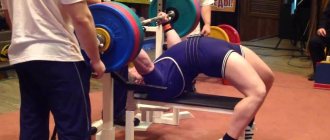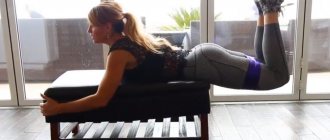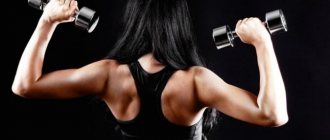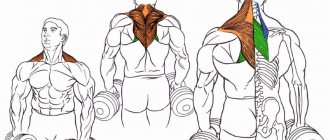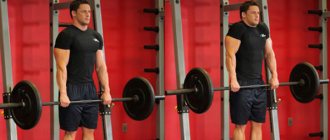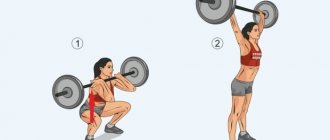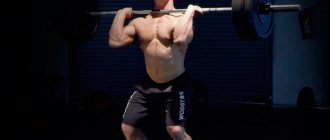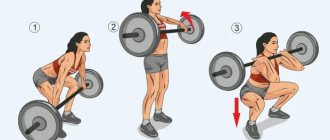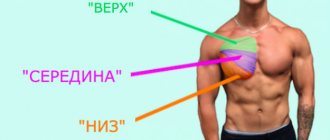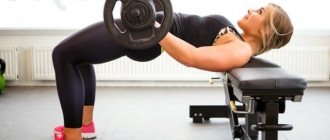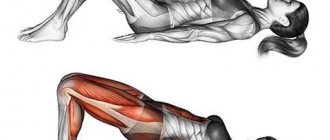- September 14, 2018
- Workouts in the gym
- Alexey Dernov
Since antiquity, developed chest muscles have been the standard of athleticism and masculinity. And the bench press has long been considered the main exercise for developing the upper body. Many people would like to have sculpted chests and bench press heavy weights, but do not know what exactly needs to be done for this.
What exercises exist with a barbell on the chest, what are the anatomical features of its structure and how to squeeze the maximum weight on the barbell? We'll talk about this and much more in this article.
Anatomy and function of the pectoral muscles
Any serious business should begin with studying its basics. Since the article will focus on the development of the chest muscles, it is necessary to understand: what is the structure of the muscle group in question and what movements does it help to perform? When it comes to chest training, it usually means the development of the large pectoral muscles; they are the ones that are on the surface.
The pectoralis major muscles are fan-shaped and anatomically divided into three bundles: upper, middle and lower. The upper part is attached to the collarbone, the middle part is attached to the sternum, the lower part is attached to the anterior wall of the rectus abdominis muscle. All three parts form one tendon that connects to the top of the humerus. It is important to note that the muscle has the correct fan shape when the arm is raised up, and in the normal position of the shoulder along the body, the tendon is twisted 180° so that the tendon part of the lower fibers is higher than the tendon part of the upper portion of the muscle.
This unusual structure creates a wide motor amplitude and allows the pectoralis major muscles to participate in movements such as:
- Shoulder extension: lowering the arm in front of you.
- Shoulder flexion: Raising your arm in front of you.
- Shoulder adduction: lowering the arm to the side.
- Shoulder internal rotation: Rotating the palm towards you without rotating the wrist.
- Horizontal shoulder adduction: bringing the abducted elbow to the vertical line of the body.
The most important movement in the training process is horizontal shoulder adduction. This is exactly what we do when doing exercises with a barbell on the pectoral muscles.
Chest exercises: effective training programs
By tradition, I will give several sets of exercises for developing excellent breasts for athletes of different fitness levels.
Chest training program No. 1 (for beginners)
- Incline bench press: 2 warm-up + 3-4 x 6-12 reps;
- Dumbbell bench press on an inclined bench: 1 size. + 3-4 x 6-12 repetitions;
To get started, this will be enough for you. There is no need to do isolation exercises yet. Learn to feel your pectoral muscles. Learn to shorten them wisely. This is the key to success in pumping up any muscle group.
Chest training program No. 2 (for beginners)
When the load becomes insufficient for you (after 2-4 weeks), you can move on to the second complex. Let's add one more exercise and an additional working approach.
- Dumbbell bench press on an inclined bench: 1 size. + 4-5 x 6-12 repetitions;
- Guillotine press: 2 warm-up + 4-5 x 6-12 reps;
- Lying dumbbell fly: 1 size. + 4 x 10-15 repetitions;
Chest training program No. 3 (advanced)
So, your fitness has increased (after 1.5-3 months). It is necessary to increase the amount of work performed again. The next set of exercises is just for you.
- Dumbbell bench press on an inclined bench: 1 size. + 5 x 6-12 repetitions;
- Guillotine press: 2 warm-up + 5 x 6-12 reps;
- Raises of arms in a crossover lying on an inclined bench: 1 size. + 4-5 x 10-15 repetitions;
- Crossover while standing: 1 size. + 4-5 x 10-15 repetitions;
This is already a very serious load. You will already notice how your pectoral muscles have become fuller, larger and juicier.
Further, I think there is no point in listing possible sets of exercises, because for 99% of beginners this will be enough. There are a huge number of alternatives.
Next, for example, you can add training of the slow muscle fibers of your chest to the end of your workout. Fantasize, friends, look for the optimal solution specifically for yourself and listen to your body! It will never deceive you.
How to pump up your chest?
In order to give your chest a voluminous, powerful appearance and maximize its strength characteristics, you need to carefully approach training planning (which will be discussed below) and selection of exercises. Since three parts (bundles) are distinguished functionally and anatomically, either separate exercises have been developed for each, or the nuances of the main exercises that affect different parts of the muscle are described.
Very often you can meet such guys who have developed lower, less developed middle and completely unprominent upper parts of the pecs. Such disproportion visually creates the impression of sagging breasts, which does not exactly contribute to the aesthetics of athleticism. It is formed in those who do, for example, bench press on a horizontal bench in a strength (powerlifting) style, with a chest bridge. This style of bench press allows you to squeeze out more weight, but, alas, most of the load goes to the lower part of the pecs, which hypertrophy more than the upper ones.
How to pump up your chest with a barbell, the support of exercises and the nuances of execution will be discussed below, but for now it’s worth considering the basic rules for strength training.
Dumbbell flyes lying on an incline bench
This exercise for the upper part of the pectoral muscles gives a distinct shape to the top of the chest, specifically highlighting its inner upper edge. Recommended for everyone, from beginner to experienced athlete, to perform in the middle or at the end of a workout after barbell and/or dumbbell presses.
Exercise technique
1. The exercise is performed on a bench with an inclination of 30-45 relative to the horizontal. Lie down on a bench, keep your back straight, place your feet wider than your shoulders and rest them on the floor. 2. Bring the dumbbells together over your upper chest. The elbows are slightly bent. The angle at the elbows remains the same throughout the entire approach. 3. Inhale, hold your breath and spread your arms to the sides. At the same time, the elbows look to the sides; you cannot turn them towards the body. 4. At the bottom point, without delay, change the direction of movement and slowly bring the dumbbells together over your chest so that they lightly touch. 5. Exhale only after overcoming the most difficult part of the dumbbell movement.
Technique tips
- Unlike bench press exercises, the weight in flyes should be slightly reduced, since proper technique is more important than heavy weight.
- By performing flyes with straight arms, you put dangerous stress on your elbow joints. The elbows remain in one constant, slightly bent position throughout the entire approach.
- Do not lift the dumbbells excessively. By lowering them below shoulder level, you risk injuring the shoulder joints, which can also lead to tendon rupture.
- Holding your breath, as well as the rigid position of your feet on the floor, guarantee a stable position of the body on the bench during the exercise.
- The pace of the exercise should not be too high, as this will cause the technique to suffer and the flyes will look more like a bench press.
- Control the range of motion of the dumbbells and do not move them back behind your head or forward towards your stomach. This way you can lose control over them and miss them.
Rules for the lesson
All exercises with a barbell on the chest are multi-joint, and, accordingly, basic, including the shoulder and elbow joints. The assistants are always the triceps and the anterior portions of the deltoid muscles. Since the exercises are basic, in addition to the muscle groups actively involved in the movement, almost the entire body is in tension, maintaining balance and coordination.
The above factors can lead to injury if the following principles are not followed:
- High-quality warm-up: before the strength part of the workout, you should do a light warm-up on a cardio machine (5-10 minutes); Carrying out soft rotational movements, perform articular gymnastics on all the main joints of the body; Before each exercise, do several warm-up approaches, performing movements with light weight or a small number of repetitions without significant fatigue.
- Study, adherence and improvement of exercise technique. At the beginning of classes, it is advisable to use the services of a personal trainer, who will introduce you to the basics of the training process and teach the correct exercise technique. During training, you should always be focused on performing the movement and constantly improve your technique.
- Ensuring full recovery. It is not recommended to exercise more than 3-4 times a week; it is necessary to take rest days between workouts. Sleep is extremely important, the duration of which should not be less than 8 hours a day. The effectiveness of the training is directly proportional to the nutritional value, which should provide the body with all the necessary nutrients, vitamins and microelements. The volume of clean water drunk per day should be at least two liters.
- Help from the insurer. To avoid injuries, it is necessary to have a training partner or ask a trainer to help remove the barbell from the racks and belay during the exercise.
For the purpose of building muscle mass, we pump the chest with a barbell with a weight that will allow you to complete 3-6 working approaches of 8-12 repetitions in each. The last approach should be a failure - this is when there is no strength to complete another repetition.
Exercises to increase chest muscles
Now we will analyze the most effective and proven methods of breast pumping, which were tested and selected by me personally.
Over the years, I continue to maintain the shape and tone of my pecs with the following exercises. I would like to note that the exercises are also designed for beginners, so young men or boys will be able to apply the information to maximum benefit without any problems.
Once again, I want to remind you that every workout, even the shortest one, should begin with a warm-up for the whole thing, regardless of whether you work your arms or just your chest. Therefore, a 10-15 minute warm-up will help avoid sprains and more serious injuries, remember this!
How to do push-ups to pump up your pectoral muscles
This is one of those exercises that is often overlooked but will help you strengthen your shoulders and upper chest muscles. Take a lying position, hands shoulder-width apart, legs extended. Rise up until your elbows are straight and then lower back down to the floor.
- Do three sets of fifteen push-ups each. If this is too hard for you, reduce the number of push-ups. If, on the contrary, you feel that you can do more, do more repetitions.
- Push-ups also train the triceps and shoulder muscles.
- As an alternative, you can try the following exercise: Before performing the exercise, place your feet on something solid to elevate them. This will give your shoulders and upper chest muscles more tension and therefore be healthier for you. Or you can do push-ups with extra weight on your back for a more intense chest workout.
Push-ups with legs elevated
Push-ups with extra weight on your back
How to pump up your pectoral muscles with a barbell
There is a reason why this exercise is the most popular exercise for strengthening the pectoral muscles. Set the barbell to the weight that suits you. Lie down on a bench with your feet on the floor. Lower the barbell to your chest so that there is still about 2.5 cm . Then lift the barbell up.
- In order to build muscle mass, you need to perform this exercise 8 - 12 times in 3 - 5 approaches . This will help pump more blood into the pectoral muscle, and with it more nutrients for better growth.
- You can also try this exercise on an incline bench. This will put more strain on the upper chest muscles. By doing the head down exercise, you can train your lower chest muscles. Most people do not attach importance to these exercises, but they are especially important for the formation of the correct shape of the pectoral muscles.
How to pump up your pectoral muscles on the uneven bars
Do a dip and then slowly return to the starting position. This exercise may seem difficult for beginners, but it will help you quickly achieve a beautiful breast shape.
With the help of parallel bars you can significantly pump up your chest muscles. And I am a supporter of this particular exercise. There are quite a lot of techniques and programs for practicing on the uneven bars, but if you are a beginner, I advise you to start small. For now, let's look at the most basic aspects of this exercise.
- The optimal number of repetitions for beginners would be 3 sets of 15-20 repetitions . Men with a good level of physical fitness can perform 4 sets of 25-30 repetitions . Personally, I found the formula for myself: 1 set (warm-up) 20 repetitions , then 3 sets of 15 reps with additional weight.
- Dips on the uneven bars to work the pectoral muscles should be done slowly, without sudden jerks or jerks, so the result of the workout will be as effective as possible.
Concentrate on the pectoral muscles separately
Lie on the floor in a supine position, as if you were about to do push-ups. Hold this position for 3 seconds and then shift your weight to the right side of your body. Raise your left arm and leg into the air so that your posture resembles a star pose. Stay in this position for 3 seconds . Then repeat this exercise with your left arm and leg. Hold this position again for 3 seconds.
Exercise machines or free weights
The main advantage of free weights is their wide availability: in any gym there is a barbell, a bench for pressing, a power rack for squats and several dumbbells. In this sense, it is more difficult with simulators. Not every gym has modern equipment, but most of the gyms have the most necessary equipment, including the most popular exercise machines.
In order for anabolic processes in muscles to occur at the highest possible level, several principles must be observed. And one of the primary conditions is an increased level of hormones such as testosterone and somatotropin (growth hormone). Increased secretion of these hormones can be achieved purposefully. To do this, you need to perform basic (multi-joint) exercises that involve several muscle groups.
Performing multi-joint exercises with free weights allows you to engage not only the target muscles (which we purposefully train). Synergistic muscles and muscles that help maintain balance and coordination are also actively contracted. This effect cannot be achieved when working in a simulator, where the trajectory of movement is specified by the design of the machine.
Seated chest press
Reason for inclusion in the list
The free weight flat bench press is a great exercise, but the bench press machine also has some useful features. For example, you can slow down the repetition in both the concentric and eccentric phases. Weight-bearing machines are great for quickly performing drop sets.
EMG analysis showed that the bench press in the machine involves much less of the bundles (anterior, middle and posterior) of the deltoid muscles compared to exercises with free weights. This is due to the reduced need to stabilize the shoulder joint and allows for better development of the pectoral muscles.
SEATED CHEST PRESS
Place in the training program
Let us remind you again, perform exercises in the machines at the end of your workout. For those who want to gain muscle mass, exercise machines provide an excellent opportunity to pump up the chest muscles with minimal involvement of the shoulders.
Incline dumbbell press.
Reason for inclusion in the list
Dumbbell presses are an essential chest exercise in your training regimen, but with an adjustable bench you can do a number of things that you could never do on a non-adjustable bench. Here's our favorite tip: change your incline angle after each set or after each workout. This will allow you to work out muscle groups more thoroughly.
INCLINE DUMBBELL PRESS
Place in the training program
The incline dumbbell press is rarely performed at the beginning of a workout, but you can safely include it among the first three exercises. Remember, however, that the later you start, the less weight you will probably be able to lift.
To increase the effect of the exercise on the muscles, slowly turn your hands inward in a concentric phase and bring the dumbbells together at the top point. This small change will cause the upper arm to rotate, thereby strengthening the pectoralis major muscles.
Dips
Reason for inclusion in the list
First of all, make sure that when doing dips, you focus on your chest muscles. Bend your knees and take them back, lean forward as far as you can and spread your elbows out to the sides as you lower yourself. Dips are a great alternative to the incline bench press, and they don't require any support.
PUSH-UPS
Place in the training program
If you are an experienced athlete and confident in your abilities, this exercise will serve as a worthy end to your workout; if not, then it is better to do it at the beginning. When performing a superset at the end of a workout, it is very good to combine dips with regular push-ups.
Reduction of arms on an inclined bench in a crossover
Reason for inclusion in the list
There aren't many single-joint exercises on our list, but this is one of our favorites. This effective isolated chest exercise is best performed after completing multi-joint exercises. The weight blocks of the simulator allow you to keep your muscles tense throughout the entire range of motion.
CROSSOVER HANDS ON AN INCLINE BENCH
Place in the training program
Do this exercise with increased repetitions (10-12 per set) at the end of your workout. If you're training with a partner, do a few drop sets and push yourself to the max, which will only have a positive effect on muscle growth.
Incline Dumbbell Pullover
Reason for inclusion in the list
Look for effective exercises for the chest muscles, then forget about pullovers on a horizontal bench, because the incline allows you to keep the muscles tense throughout the entire range of motion! Lie with your back on the bench, having previously set it at an angle of approximately 45º, and make sure that there are no obstacles above your head. Be careful to perform this single-joint exercise correctly—do not bend or straighten your elbows.
PULLOVER WITH DUMBBELLS, LYING AT AN ANGLE
Remember that you must understand the meaning of every movement you perform. Pullovers stretch the shoulder muscles (when you lower your arms behind your head), which allows you to work your chest muscles well.
Place in the training program
Do pullovers at the very end of your workout. The approach should include 12 repetitions. On each set, hold the peak muscle contraction of the last rep for 5 seconds.
Reduction of arms in the butterfly simulator
Reason for inclusion in the list
The machine or dumbbell curl is difficult to master due to the fact that your elbows must be slightly bent throughout the exercise. Fortunately, the butterfly machine makes the task easier because it allows you to maintain the correct position throughout the entire amplitude. This machine will be a great teacher for you, and it also frees you from having to balance the weight.
EMG data shows that activation of the pectoralis major and anterior deltoids is similar during the bench press and the seated abduction machine. This means that even if you perform each of these exercises for a different number of repetitions, you will certainly be pleased with the excellent results in developing the chest muscles using the butterfly machine.
HANDS IN THE “BUTTERFLY” EXERCISER
Place in the training program
Do the exercise at the end of your workout. Each approach should include 10-12 repetitions. Perform drop sets and partial reps, and practice training to failure.
These are the best exercises for the pectoral muscles in the gym, but if you have the appropriate equipment, you can pump up your chest at home.
Bench press
The main basic exercise for the pectoralis major muscles is the bench press. This is also the only way to train your chest with a barbell. To perform it, you need not only weights, but also a special bench (preferably with an adjustable inclination) with racks. In terms of its biomechanics, the movement resembles a deadlift with an emphasis on the chest with a barbell, but only in reverse.
Technique:
- Lie down on the bench so that the bar is directly above your eyes; bring your shoulder blades together; rest your feet on the floor; squeeze the bar tightly with your hands.
- As you exhale, use a powerful force to remove the projectile from the racks and fix it on your straight arms. For this phase of the exercise, it is imperative to use the help of a spotter - this will help minimize the risk of injury.
- Smoothly lower the bar to the line of the nipples, avoiding bounce; simultaneously fill the chest with air, feeding it towards the projectile.
- With a powerful force, press the bar upwards forward so that in the final position it is again above the eyes. The stroke of the bar is not perpendicular to the floor, but has an arc trajectory - from the line of the nipples to the line of projection of the eyes.
- If necessary, repeat steps 3 and 4 until the planned number of repetitions is completed or until the moment when there is no strength left to continue the exercise.
- Return the projectile to the racks, using the help of a belayer.
How to change the bench press to suit your needs
There are several bench press options that will allow you to shift the load on different muscles. Focus on your goals.
If you want to better load the upper chest
The pectoral muscle consists of two bundles: upper and lower. In the classic bench press on a flat bench, more load is transferred to the lower beam. If you want to shift the load to the upper The Effects of Bench Press Variations in Competitive Athletes on Muscle Activity and Performance part to evenly pump the entire chest, try the incline press.
Set the bench to 45° and perform the exercise, observing all the technical points for the bench press.
Be careful with the weight: while the angle of work is unusual, take 20% less than usual.
If you are going to pump up your triceps
To shift the load on your shoulder muscles, grab the barbell with a close grip. Do not clasp your hands together, place them on the palm of your hand with a normal grip.
In addition to the additional The Effects of Bench Press Variations in Competitive Athletes on Muscle Activity and Performance load on the triceps, this option puts a little less stress on the shoulders. So, if you have problems with the shoulder joint, a narrow grip can help.
If you want to overcome the plateau
If the weight on the barbell bench press is stagnant, try changing free weights and performing the exercise with dumbbells. This press pumps up the chest muscles as effectively as the barbell version, and the unusual movement can provide the necessary stimulus for further growth.
Don't rely on your barbell working weights: your shoulders will have to work to stabilize the position, which means you need to choose a much lighter weight. And be careful when taking the starting position so as not to injure your shoulders.
In the video below, Jeff Cavaliere shows how to do this as safely as possible.
In addition, to increase the weights in the bench press, it will not be superfluous to work on the auxiliary muscles.
Evgeny Pronin
To develop the bench press, it is useful to train the latissimus and stabilizer muscles: biceps, middle and rear deltoids.
Look for the most effective exercises for biceps, back and shoulders in our articles.
Add to bookmarks
